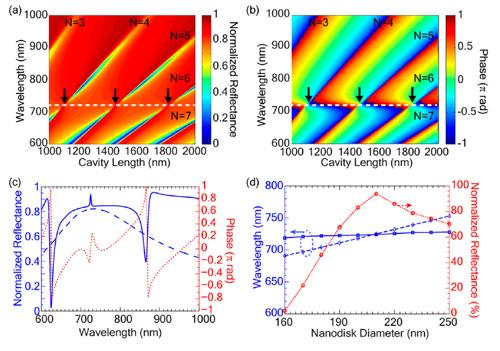Cavity-coupled plasmonic device with enhanced sensitivity

© 2015 EPFL
Using full-wafer processing, we demonstrate a sophisticated nanotechnology for the realization of an ultrahigh sensitive cavity-coupled plasmonic device that combines the advantages of Fabry-Perot microcavities with those of metallic nanostructures. Coupling the plasmonic nanostructures to a Fabry-Perot microcavity creates compound modes, which have the characteristics of both Fabry-Perot and localized surface plasmon resonance (LSPR) modes, boosting the sensitivity and figure-of-merit of the structure. The significant trait of the proposed device is that the sample to be measured is located in the substrate region and is probed by the compound modes. It is demonstrated that the sensitivity of the compound modes is much higher than that of LSPR of plasmonic nanostructures or the pure Fabry-Perot modes of the optical microcavity. The response of the device is also investigated numerically and the agreement between measurements and calculations is excellent. The key features of the device introduced in this work are applicable for the realization of ultrahigh sensitive plasmonic devices for biosensing, optoelectronics, and related technologies.

This figure shows colormaps of (a) normalized reflectance and (b) phase difference as a function of the wavelength and cavity length
for cavity-coupled plasmonic structures shown in the sketch on the top of the page. (c) Normalized reflection spectra (blue solid line) and phase difference (red dotted line) for a cavity-coupled plasmonic structure for 1830 nm cavity length. The reflection spectrum for a bare two-dimensional gold nanodisks array without the underlying Fabry-Perot cavity is also shown as blue dashed line.
(d) LSPR wavelength for a bare two-dimensional nanodisks array (blue dashed line) and the normalized reflectance (red dotted line) for the second mode of the proposed cavity-coupled plasmonic structure as a function of the size of the nanodisks. For clarity, the corresponding Fabry-Perot mode, which results in constructive interference, is also shown (blue solid line). For the phase plots, the phase difference of the transmitted light outside the cavity with the reflected light from the nanodisks array are calculated and shown.
Check the corresponding publication: PDF External link: doi:10.1021/acsnano.5b02977